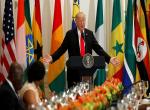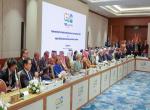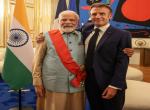India’s relations with the Islamic Republic of Iran over the last few years have been marked by various hurdles. These pertained to the unresolved payment imbroglio for the import of Iranian crude oil; inability to streamline trade between the two countries and various other issues. These limitations have cropped up ever since the United States imposed economic sanctions on Iran for its controversial nuclear programme. The sanctions have led to negative impacts on India’s overall bilateral relations with Iran. This is evidenced by the visible fluctuation in the bilateral trade figures for the last few years. While Indian exports to Iran have witnessed an increasing trend, similar is not the case with that of imports from Iran. However, with the interim nuclear accord signed in 2013 between Iran and the West, there had been some improvements in the overall bilateral ties between India and Iran. Simultaneously, the newly elected government in New Delhi is likely to give more impetus to the energy-driven relations between the two countries. Having said that, the ties between the two countries would largely depend on how far both the countries could manoeuvre through the US pressures, in case the ongoing talks on nuclear standoff fails to bring any solution. Tellingly, the role that India and Iran could play in Afghanistan is going to be one of the most challenging tasks for both the countries.
Indo-Iranian Ties after the 2013 Geneva Nuclear Accord:
Going back to November 2013, when Iran and the West struck an interim nuclear accord in Geneva, one country in South Asia that observed the development anxiously was India. After the Geneva nuclear accord was signed, several reports surfaced analyzing how India is going to benefit from the breakthrough. For many, this interim nuclear deal was considered as a landmark deal while countries such as Israel watched it with jaundiced-eyes and denounced it as a "historic mistake.” In India, there was optimism and pessimism over the improved US-Iran ties. While some talk of an overall boost in India-Iran relations, particularly in trade and energy-related relations, others say the deal was only for six months and there would not be anything substantial that New Delhi could benefit from. That said, one of the most important advantages for New Delhi, according to Indian experts, is that it would now be able to play an active role in Afghanistan as a check against the Taliban, which could be helpful in the former's endeavours to strengthen its foothold in Central Asia. Simultaneously, India could also streamline its trade and business with Tehran, which have remained constrained due to the US-led sanctions since many years. There were others who were of the opinion that an immediate impact could be felt on the shipping activities which have remained visibly hampered due to the sanctions imposed. Most importantly, India's import of Iranian crude oil was expected to witness some flow in 2014. There were developments during late 2013 which signalled a possible revival of military-security cooperation between India and Iran that has become non-existent since mid-2000s.
Owing to the aforementioned interim nuclear deal, there was a considerable increment in India’s oil imports from Iran. According to a report, in 2014, India imported 42 percent more Iranian oil as compared to 2013. By December 2014, India imported 348,400 bpd. With this, Iran emerged as the seventh biggest oil supplier to India in 2014, in terms of volume. Although India cleared the dues for the Iranian crude oil import in rupees, the issue of payment mechanism came up intermittently, and this at times undermined the overall trade between the two countries.
As energy ties have remained the most important factor in India-Iran ties, both the countries explored further means to enhance this aspect of their cooperation. During early 2014, India opened formal talks with Iran and Oman for building a deep-sea gas pipeline. This could be viewed as an attempt to avoid the route through Pakistan. Increasingly, security concerns of carrying gas over land have led New Delhi to come up with this idea. For the moment, this pipeline looks to be the “most promising” option available to India. The pipeline, which is planned to be 1,300 kilometre (km) long, upon completion, would transport 8 trillion cubic feet (tcft) of natural gas to India over a period of 20 years. The estimated cost for this project currently stands at US$4-5 billion, and it would take four to-five years to complete the construction. This would not only facilitate energy trade but would also generate more power in India. Other projects such as Turkmenistan-Afghanistan-Pakistan-India (TAPI) gas pipeline is unlikely to be favoured by India, considering the problem of instability inside Afghanistan and Pakistan. But with Oman, India’s proximity to the West Asian natural gas resources becomes closer and the landed cost will be lesser by US$1.5 to US$2 per million BTU. As a result, this appears to be more feasible at this juncture when India’s demand for energy is increasing manifold.
During 2014, Indian exports of pharmaceutical and electrical products, tea, rice, sugar, etc. received good dividends. To facilitate more economic cooperation, particularly in non-oil items, Iranian officials have requested India to open more accounts in different banks but the Reserve Bank of India (RBI) has certain restrictions. Such moves could, otherwise, speed up the commercial transactions between the two countries. Discussions for various investments by Indian firms, including, Special Economic Zones (SEZs) in fertilizers and petrochemical sector, in Iran have already been conducted, and it is now up to both the governments to materialise those projects and proposals without further delay.
On military-security affairs, cooperation between India and Iran has become non-existent. Going back little more than a decade, a considerable defence relationship was maintained between New Delhi and Tehran, and it was given heightened importance with the signing of a strategic partnership accord during the visit of the then Iranian President Mohammad Khatami to New Delhi in January 2003. However, with the signing of the Indo-US nuclear deal in 2005, India’s defence ties with Iran began to dissipate considerably. Nevertheless, with the visible change in the geopolitical and geo-strategic relations, both the countries discussed the possibility resuming defence ties, but that is unlikely to happen soon. In fact, in July 2013, the Iranian Ambassador to India Gholamreza Ansari expressed interest in enhancing defence ties with India, a sentiment that was reciprocated by the then Indian Defence Minister A. K. Antony. Discussions were held to initiate more bilateral defence exchanges between the two countries. In December 2013, two Iranian warships and a submarine paid a “goodwill” visit to Mumbai, and naval officials from both countries called for close naval cooperation. In addition, the need for a “framework for joint cooperation and security for vessels in India’s western waters to the Persian Gulf” was suggested.
Furthermore, acknowledging the achievements made by defence industries of both the countries, the Iranian ambassador emphasized on his country's readiness to exchange experience with India. However, it is still too early to predict resumption of a strong cooperation in this field. But if it happens, Iran would obviously like to lure the Indian defence planners with its military and defence equipment such as ground surveillance radar systems, personnel carriers, drones, destroyers, submarines, and missile-launching frigates. If this aspect sees the light of the day, then Tehran might use its military sales both as a means to gain political support as well as to revive its crumbled economy. Tellingly, this is a potential area where India’s strong defence partner Israel would be watching very cautiously and the latter would be concerned if New Delhi begins military cooperation with Tehran.
Although India supports Iran’s right to civil nuclear programme, there had been instances in the past when New Delhi voted against Iran at the International Atomic Energy Agency (IAEA) for its noncompliance to disclose intentions of its nuclear program. And India’s stand on Iranian nuclear programme is one issue, which at times, comes at odds with Israel. For instance, in June 2013, Israeli President Shimon Peres voiced his concern over the Iranian nuclear program and even urged India not to remain "neutral" to the issue. That said India and Israel continue to nurture their bilateral ties very maturely, even if they do not share the same views with regard to Iran's program. India, however, must be cognizant of the changing reality of the Israeli-Iranian standoff. As a result, it must strive unrelentingly to convince both the Middle Eastern countries, by playing the role of a mediator, to solve their crisis through diplomatic measures.
To avoid any negative fallout, India has the huge task of safeguarding its ties with both the archrivals of West Asia depending on its national interests: one for security and technological needs and the other for energy security. And the present government under the leadership of Prime Minister Narendra Modi is gradually steering an independent foreign policy approach in West Asia, and it is going to do the same with Iran and Israel as well. The government should separate its Iranian policies from that of Israeli strategic policies and should not let one dictate the other. Likewise, owing to the growing economy of India, it should be in the interest of Iran and Israel to conduct business with New Delhi purely based on their interests.
India and Iran in Afghanistan:
Afghanistan has increasingly become an important country for both India and Iran. While its importance has been realised since last few years, attempts to play a proactive role inside the country has gained momentum after the US announced the drawdown of its troops from this war-torn country. And visible developments had begun after the 2013 interim nuclear deal. India and Iran accelerated their commercial and energy trade. Along with this, they have begun to explore further possibilities to rope in Afghanistan as the latter could provide an important link in building more cooperation between them, and at the same time, provide opportunities to Kabul in reconstructing their economy. In short, Afghanistan has become a strategic asset that India and Iran would like to benefit from. An analyst once noted that, “While India looks at Afghanistan more from the prism of regional peace and security, for Iran, Afghanistan presents an opportunity to establish its credentials as a responsible regional player.”
Throughout 2014, most of the political discussions between Indian and Iranian officials were heavily concentrated on combating the rise of violence and extremism in the region. In this, maintaining peace and stability inside Afghanistan has also remained an important agenda for New Delhi and Tehran. These issues were flagged during the visit of Iranian Foreign Minister Javad Zariff to India in February 2014. Apart from the security issues, the need to develop the Chabahar port for the augmentation of trade has been given utmost attention. The visit of the India’s National Security Advisor Ajit Doval to Iran during early-February 2015 laid immense importance to these potential areas of cooperation. This port was a dream project of the former Indian Prime Minister Atal Bihari Vajpayee, who, during Khatami’s visit in 2003, had signed a Memorandum of Understanding for its development. But the previous United Progressive Alliance government did not carry out substantial work on this port as, according to another known India strategist, they “failed to get their act together on critical projects involving India’s national security.”
Finally, five months into the formation of the Bharatiya Janata Party (BJP) government in New Delhi under the leadership of Narendra Modi, the cabinet approved India’s participation in the development of Chabahar port in Iran. The government sanctioned approximately US$85 million for the construction of two berths that would include container terminal and a multi-purpose cargo terminal. The project which is likely to be completed in 18 months would be used to ship crude oil and urea, along with other trading items. This has become the first major breakthrough in New Delhi’s Iran policy ever since the new government was elected.
The importance of this port lies in the fact that it would offer an alternative route to the landlocked Afghanistan and resourceful countries in Central Asia without actually depending on Pakistan. Moreover, for India, Chabahar port would not only give an easy access to these mentioned countries but it would definitely serve its strategic interest, particularly at this juncture when the Chinese are investing heavily in Pakistan’s Gwadar port, which is roughly 76 km from this port in south Iran. It is a known fact that China wanted to invest in Chabahar’s development due to which India had gone into intense negotiations with the Iranian authorities. Otherwise, China’s involvement in this port would have come to the utter dismay of India. From this, it is evident that the energy-rich West Asia has become a region where India and China would like to wield their influence for their own regional aspirations. Now, as the US, that once rejected India’s role in Chabahar port, shows its favour, it is a herculean task for the three governments in India, Iran and Afghanistan to engage and negotiate constantly to benefit from this very potential port project. Nonetheless, the escalation of terror activities inside Afghanistan is likely to appear as a limiting factor in the furtherance of this project. India, very recently, has already shown its unwillingness to add more finance. Only Time can tell the progress on this front.
From the above developments, it has become clear that the present-day Indo-Iranian ties are full of prospects and challenges. Therefore, constant efforts have to be made by New Delhi to preserve the ties with Iran, keeping in mind the energy-security interests of the country along with other economic opportunities and regional dynamics. However, the talk that is going on between Iran and the West to settle the nuclear standoff would largely impact on India’s policies towards Iran. It is yet to be seen how India would manoeuvre its ties with Iran, should there be any negative fallout on nuclear talks.
Lastly, the entire West Asian region holds great importance for India; as a result, the government should keep equal focus on it as they are doing with the other Asian nations. India needs to carefully craft its foreign policies with the countries mentioned above, with a clear vision of its national interests. This region can also be a test for Modi’s foreign policy overtures.
Published Date: 20th February 2015, Image source: http://www.iranreview.org
(Disclaimer: The views and opinions expressed in this article are those of the author and do not necessarily reflect the official policy or position of the Vivekananda International Foundation)










Post new comment